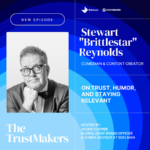By Winston Li, Founder, Arima
I recently read an article in Digiday about what Chief Marketing Officers are increasingly demanding from AI in marketing. One phrase jumped out: “Practicality over pontification.”
They are not unjustified.
Marketers have always asked for more than data—they’ve asked for action. “What do I do with this?” they’d ask, after we unveiled yet another 130-slide, bar chart-packed PowerPoint presentation. “How do I make sure that the data we have is informing our actions?”
So we shifted. We talked about insights. About storytelling and limited ourselves to 20 slides. “We’re not just delivering data—we’re telling stories based on actionable insights,” we’d say. Clients would nod: “Lovely storytelling. Very inspiring. But… how do I use this to build better products? Spend my budget more efficiently? Buy smarter media and actually change behavior?”
In other words: give us less pontification, and more practicality.
This is the gap that AI and synthetic data are now closing—quickly and powerfully. These tools convert complexity into clarity, make sense of large volumes of data and turn them into actions—available to marketers at every level, regardless of their analytical background.
Synthetic data are the building blocks for Chat GPT and Midjourney, among others.
Synthetic data sounds impressive, if not provocative. What is it exactly?
Synthetic data is artificially generated data that mimics real-world data in structure and statistical properties but does not directly replicate any individual or event. It’s created using algorithms and models—often powered by machine learning or statistical methods—to simulate the patterns and relationships found in actual data. Its usage advantages are in its privacy, its reduced cost of access, speed, data availability and bias reduction. Often accessed with the help of AI assisted smart tools, synthetic data is the foundation of all practical marketing solutions.
However, not all synthetic data is created equally. Users need to ensure that the synthetic data that is being used is fit for purpose, created transparently and in a statistically defensible manner.
Here are a few examples of how to do just that:
- A global soft drink brand recognized the opportunity to place vending machines more strategically using existing data. However, their efforts were blocked by fragmented data locked in hard-to-access silos. By using AI-powered tools, they integrated sales data with location intelligence and hyper-local demographics—giving location managers a clear, data-driven view of site potential. The result? Smarter placements and higher sales.
- A clothing retailer knew it needed to rethink its store and service strategy, recognizing that consumer buying and return behaviors shifted based on proximity to physical locations. Using AI tools, the retailer combined online and offline transaction data with synthetic customer ratings and local market demographics and attitudes. This empowered them to practically tailor the right mix of in-store and digital experiences for each market. The result: increased traffic, higher margins, and improved customer satisfaction.
- A CPG company aimed to accelerate its new product development cycle to launch faster and improve the success rate of new products. By integrating AI created synthetic psychographic data into its workflow, the company rapidly screened product concepts and tested creative assets in real time—saving thousands in research costs and significantly reducing time to market.
- As it pushed into new markets, a financial services company needed to understand the market potential for a new product in the immediate trade area of its brick and mortar locations. Using localized synthetic data allowed them to understand the size and characteristics of the population near their branches. Not only did this point them to which branches to launch the product first, but also how to tailor communications specific to each community. The result was both an efficient and effective new product launch.
These tools work and should inspire all marketers, who hold back due to fear. It’s legacy. It’s the voice that says, “We’ve never needed this before,” or “AI can’t replace my gut.” The most dangerous mindset? “This will cannibalize my core business.”
Don Tapscott, one of the world’s leading authorities on the impact of technology on business, once wrote about how his kids reacted to his excitement over the internet. They likened it to someone hyping a revolutionary new home device… that keeps food cold. A refrigerator. Sometimes, practicality becomes so embedded, we forget how revolutionary it once was.
AI marketing tools are today’s refrigerator. They’re not here to replace creativity or experience. They’re here to make them more actionable. In a recently published report, Gartner predicts that by 2028, 80% of the Global 2000 will be using hyper local synthetic data and tools for significant decision-making up from just 5% today.
Marketers: it’s time to stop debating and start doing. Stop pontificating. Start practicing. Practicality wins.











